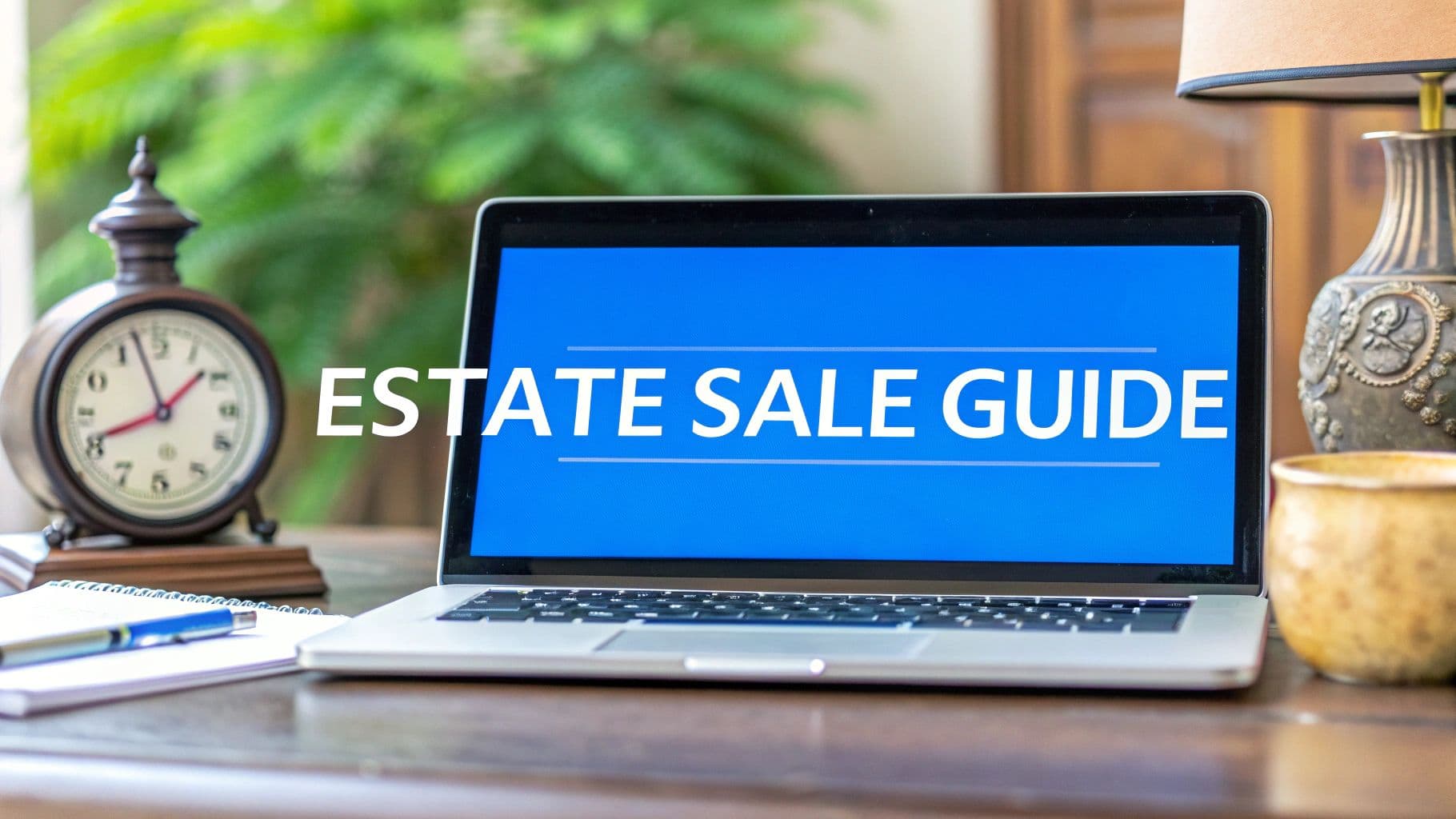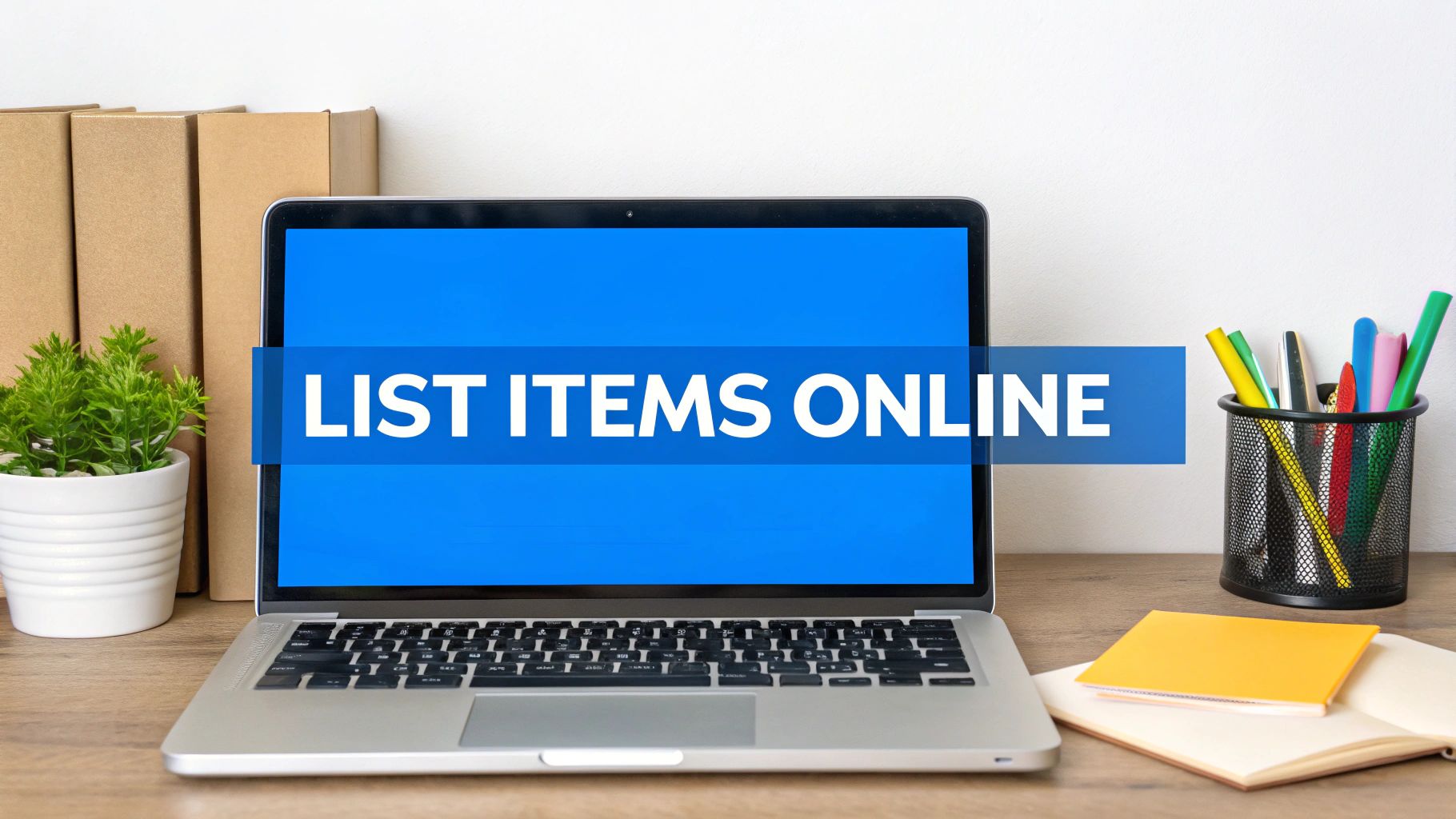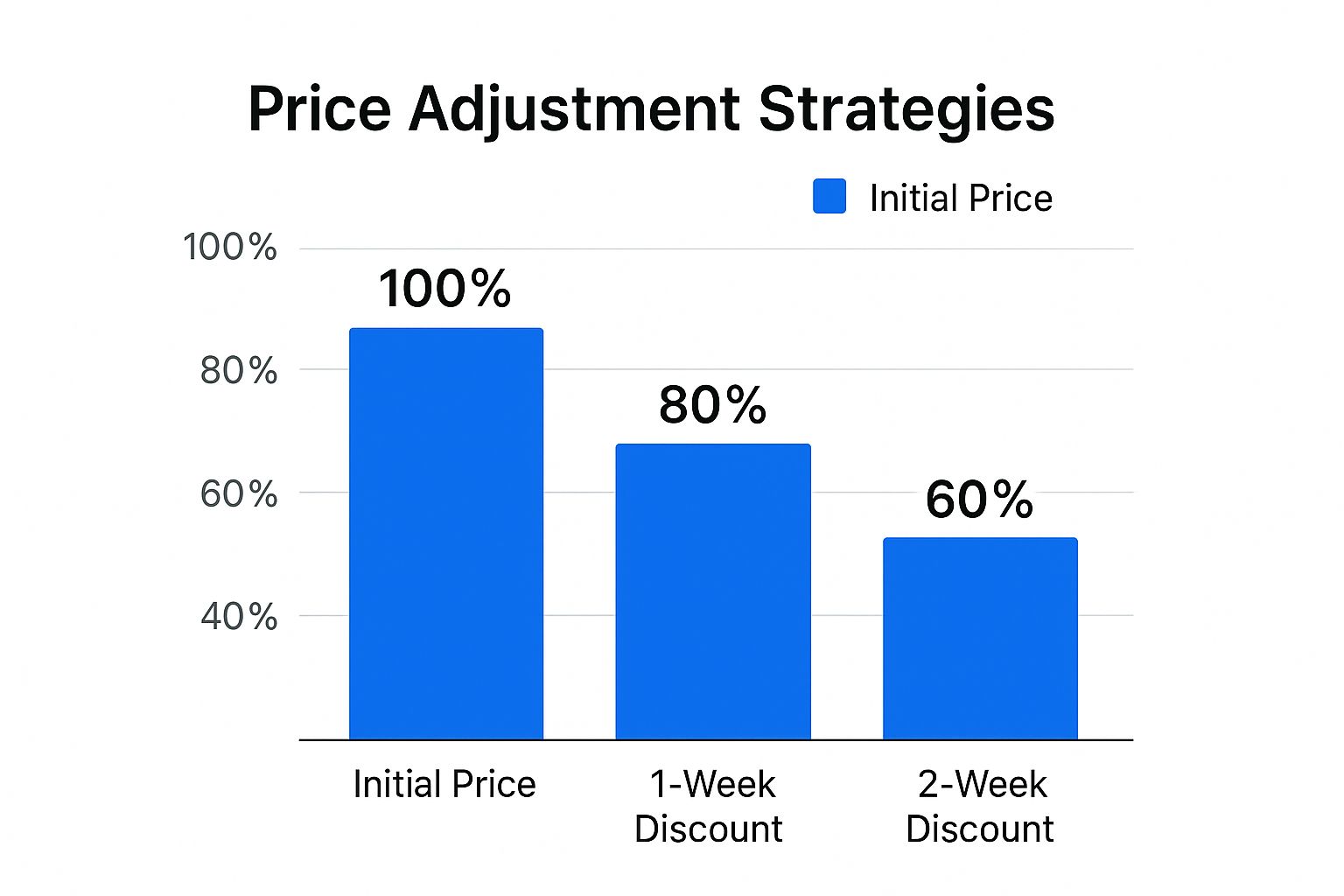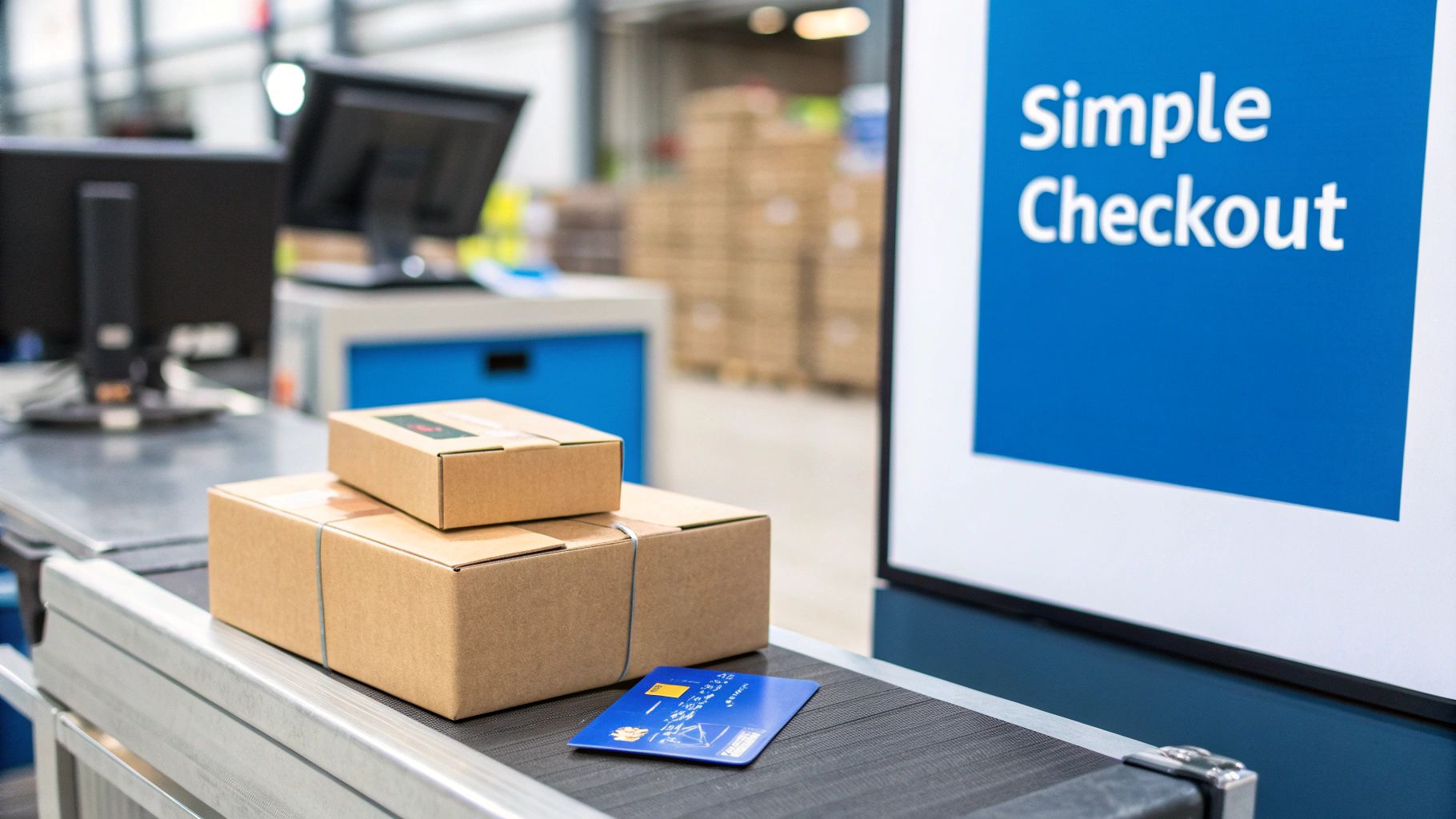Your Guide to a Successful Online Estate Sale

Think "estate sale," and you probably picture a crowded house, price-tag haggling, and a line of cars down the street. That model still exists, but the game has changed. Today, an online estate sale lets bidders and buyers shop from anywhere, using just their phone or computer.
This isn't just about putting things on the internet; it's a fundamental shift that turns a local weekend event into a nationwide marketplace.
Understanding the Modern Online Estate Sale
The days of just posting a few signs around the neighborhood and hoping for a good turnout are behind us. The modern online estate sale uses technology to create a more secure, efficient, and often much more profitable experience for sellers.
It tackles the biggest headaches of traditional sales head-on. Instead of managing waves of people walking through a private home, you control the entire auction from a screen. This dramatically reduces wear and tear on the property and boosts security.
For those considering this as a profession, it's a whole new business model. If that's you, our guide on how to start an estate sale business offers a deep dive into the industry's new landscape.
Key Advantages of Going Digital
The benefits go way beyond convenience. Taking your sale online opens your items up to a massive audience of collectors and enthusiasts who would have never seen them otherwise.
Here’s what that really means for you:
- Expanded Reach: Your listings can attract serious buyers from across the country, not just your local town. This is a game-changer for niche items like rare collectibles, valuable antiques, or specific art pieces that have a dedicated but geographically scattered following.
- Increased Security: By keeping the general public out of the home until a scheduled pickup day, you virtually eliminate the risk of theft, accidental property damage, and other liability issues.
- Convenience and Flexibility: You can catalog, photograph, and manage the entire sale on your own schedule. There’s no need to keep the house perfectly staged and "show-ready" for days on end.
This move to digital isn't just a trend; it's a booming market. The global online auction space, which is the engine driving the online estate sale, was valued at roughly USD 5.25 billion in 2023. Market projections show that figure more than doubling to an estimated USD 11.3 billion by 2032.
The main takeaway here is that online estate sales aren't just a Plan B. They're a strategic choice that provides a structured, far-reaching, and secure way to liquidate assets—often with much better financial results.
Deciding between an online or a traditional in-person sale can be tough. Each has its place, depending on your items, your timeline, and your comfort level with technology. To make it clearer, let's break down the core differences.
Online vs Traditional Estate Sale Comparison
The table below gives you a straightforward, side-by-side view to help you see which path aligns best with your goals.
| Feature | Online Estate Sale | Traditional Estate Sale |
|---|---|---|
| Audience Reach | Nationwide or even global | Limited to local shoppers |
| Security | High; no public access to the home | Lower; risk of theft and damage |
| Sale Duration | Flexible; typically 5-10 days | Limited; usually 2-3 days |
| Convenience | High; manage from anywhere | Low; requires on-site presence |
| Costs | Platform commissions (e.g., 10-40%) | Company commissions (e.g., 30-50%) |
| Best For | Niche items, high-value collectibles | Quick liquidation of general goods |
Ultimately, an online sale puts you in the driver's seat, giving you access to a bigger market and more control over the process. A traditional sale can be faster for clearing out everyday household goods but comes with more logistical hurdles and security concerns.
Turning Belongings Into a Curated Inventory
Before you can even think about listing an item, the real work of an online estate sale has to happen. This is where you transform a home filled with a lifetime of memories and belongings into a clean, organized, and sellable inventory.
This isn’t the glamorous part, but it’s the absolute foundation of a successful sale. I’ve seen it time and time again—skipping steps here will cost you both time and money down the road.
First up is the physical sort. It can be emotional, but it's essential. Walk through the house and make decisive choices. I recommend using colored stickers or just creating three distinct zones. Don't worry about pricing yet; this is purely about making a decision.
Your categories need to be simple:
- Sell: Items that have market value and are right for your auction.
- Keep: Heirlooms, personal mementos, and anything the family has already claimed. It's crucial to be disciplined here.
- Donate/Discard: Things with little to no resale value, or items broken beyond reasonable repair.
This first sweep is a game-changer. It stops you from wasting hours photographing and researching things that just won't sell. It clears the clutter so you can laser-focus on the items that will actually make you money.
Researching What Things Are Actually Worth
With your "Sell" pile ready, it's time to put on your detective hat. Pricing is a delicate art. Go too high, and you'll scare off bidders. Go too low, and you're just giving away money. The goal is to find the fair market value—what a real person has recently paid for an item just like yours.
Your best friend here is the "Sold Listings" filter on sites like eBay. Don't just look at what sellers are asking. You need to see what things actually sold for. If you have a mid-century modern credenza, search something specific like "Lane Acclaim credenza sold price" to get real-world numbers.
Pay close attention to an item's condition because it has a massive impact on value. A vintage Pyrex bowl in perfect, mint condition might pull in $50, but the exact same bowl with a few scratches and chips could struggle to get $10. Be brutally honest with yourself about any flaws during this phase.
Pro Tip: Don't just rely on national data. Check local online marketplaces, too. A huge, heavy armoire might have a lower value in your specific area if shipping isn't realistic for most buyers. This will directly affect how you set your starting bid.
Building Your Master Inventory Spreadsheet
A detailed inventory spreadsheet is your command center. Trust me, it’s more than just a list—it's the one tool that will keep you sane and organized from start to finish.
Fire up a simple spreadsheet and create these columns:
- Item #: A unique number for every item (001, 002, etc.).
- Description: Be brief but clear (e.g., "Waterford Lismore Crystal Decanter").
- Location: Where did it come from? (e.g., "Dining Room Hutch").
- Condition: Note any chips, wear, or imperfections.
- Research Notes: Paste in links to comparable sold items.
- Starting Bid: Your initial price based on research.
- Final Sale Price: You'll fill this in after the auction.
- Buyer Information: The winner's name or bidder number for easy pickup.
As you add an item to the sheet, physically label it with its Item # using a small tag or a piece of painter's tape. This one simple step makes the final pickup day smooth and prevents frustrating mix-ups.
The Non-Negotiable Step: A Professional Appraisal
For some items, your online research just won't cut it. Fine jewelry, original artwork signed by the artist, rare coin collections, or high-end antiques have nuanced value that's nearly impossible for a non-expert to gauge. Trying to price these yourself is a huge financial gamble.
This is where getting a professional appraisal becomes a non-negotiable part of the process.
An accredited appraiser gives you a certified valuation, which does two things: it ensures you’re asking a fair price, and it gives serious buyers the confidence to bid. The few hundred dollars an appraisal might cost is a tiny investment when it could prevent you from selling a $10,000 painting for $500. It protects you and legitimizes the crown jewels of your sale, attracting the collectors you want.
How to Create Listings That Compel Bidders
You've done the hard work of sorting and making an inventory. Now comes the part that actually makes you money: your online listings. Think of each listing as your digital salesperson, working around the clock to convince a total stranger to bid on your item.
Weak listings with blurry photos and one-line descriptions? They lead to crickets and disappointingly low final prices. But a compelling listing—one with great photos and a story—can spark the kind of bidding war that makes this whole process worthwhile.
It really boils down to two things: excellent photography and persuasive descriptions. And don't worry, you don't need a professional studio or a creative writing degree. All you need is your smartphone and the right approach. Your goal is to build trust and create desire, turning a casual browser into a confident bidder who knows exactly what they're getting.
Capturing Photos That Sell
Forget about fancy DSLR cameras. Your smartphone is more than powerful enough to take photos that get results. The secret isn't the gear; it's the technique.
The absolute number one enemy of a good product photo is bad lighting. It hides important details, messes with colors, and just makes things look drab and cheap.
The solution is simple: always shoot in natural, indirect light. Find a spot near a large window, especially on an overcast day. If the sun is beaming in, just hang a sheer curtain to soften that light. This creates a gentle, even glow that shows off the item’s true texture and color without harsh shadows. And whatever you do, avoid your phone's built-in flash. It creates nasty glare and makes everything look flat.
A complete photo set should tell the whole story of an item:
- The Hero Shot: Start with a clear, well-lit photo of the entire item. Put it against a simple, neutral background like a plain wall or a bedsheet.
- All The Angles: Don't leave anything to the imagination. Show the front, back, sides, top, and bottom.
- The Details: Zoom in on what makes the item special. Is there a maker's mark? Intricate carvings? Unique hardware? Show it off.
- Sense of Scale: For smaller items, it can be hard to judge size from a photo. Just place a common object, like a soda can, next to it for instant context.
- The Flaw Shot: This is critical. Be completely honest and take a clear, close-up photo of any scratch, chip, stain, or other sign of wear.
Being transparent about flaws is your most powerful sales tool. A buyer who sees you’ve honestly pointed out a small chip is far more likely to trust that the rest of your description is accurate. That confidence leads directly to more and higher bids.
Writing Descriptions That Convert
Your photos grab their attention, but your words are what seal the deal. A great description does more than just state the obvious. It provides critical details, tells a bit of a story, and uses the keywords that collectors and enthusiasts are actively searching for.
Start with a clear, descriptive title. "Old Chair" won't get you very far. Instead, try something like, "Vintage Mid-Century Modern Adrian Pearsall 'Grasshopper' Lounge Chair." That level of specificity is exactly what attracts the right buyers from the get-go.
Next, give the item some life. Where did it come from? What makes it special? Don't just list the dimensions for a cedar chest. Try something like this: "This solid cedar hope chest was a wedding gift back in 1952 and has been in the same family ever since, carefully protecting linens in an upstairs hallway." That little bit of story creates an emotional hook.
Of course, you also need to include the practical details every buyer looks for:
- Dimensions: Always include length, width, and height. For furniture, this is non-negotiable.
- Materials: Be precise. Is it solid oak or a veneer? Sterling silver or just silver-plated?
- Condition: Describe the flaws you photographed. Use clear terms like "minor scuffs consistent with age" or "small chip on the rim."
- Provenance: If you know the item's history or where it came from, share it!
Pricing is another piece of the puzzle. For a complete walkthrough on setting competitive starting bids that still maximize your profit, check out our guide on how to price estate sale items.
Here’s a fantastic example of an online estate sale listing that puts it all together—clear photos and all the essential details right up front.

This listing does a great job using a photo gallery to showcase the items while also including a map and sale hours. It gives potential buyers all the information they need in a single glance. By combining strong visuals with clear, concise information, you empower people to bid quickly and confidently—and that’s the key to a successful online estate sale.
Choosing the Right Platform to Host Your Sale
Picking the right online venue for your estate sale is one of the most critical decisions you’ll make. This single choice affects everything—your workload, how much money you make, and frankly, your stress level. You have a lot of options out there, and they all work a little differently. Your job is to find the one that fits what you’re selling and how hands-on you want to be.
It really boils down to one question: How much of the work are you willing to do yourself? Answering that will point you toward either a full-service company or a do-it-yourself (DIY) platform.
Full-Service vs. DIY Platforms
Full-service companies like the well-known Everything But The House (EBTH) are essentially consignment partners. They swoop in and handle almost everything: professional photos, cataloging, marketing, payments, and even shipping. This is a lifesaver if you're short on time, live out of state, or just feel overwhelmed by the whole thing. The convenience comes at a price, though. Expect to pay a hefty commission, often between 30% to 50% of the final sales.
At the other end of the spectrum, you have DIY platforms. These sites give you the digital tools to run your own show. You’re in the driver’s seat—taking the photos, writing descriptions, setting prices, and managing the pickup day. It’s definitely more work, but the reward is keeping a much bigger slice of the pie. If you're organized, don't mind a little tech, and want to maximize your profit, this is the path for you.
The bottom line is, there’s no single "best" choice. It all depends on your situation. If you need convenience and professional management, go full-service. If you want more control and more profit, go DIY.
The whole estate sale industry is incredibly stable. In fact, the market in the U.S. hit an estimated $230.3 million in 2024. This growth is driven by a real need as more families look for help managing and selling personal estates. You can explore more about these industry trends to get a feel for the market you’re stepping into.
Online Estate Sale Platform Options
To help you decide, here’s a quick breakdown of the different types of platforms available. Each has its pros and cons, so think about what aligns best with your goals.
| Platform Type | Examples | Fee Structure | Best For |
|---|---|---|---|
| Full-Service | Everything But The House (EBTH), MaxSold | Commission-based (30-50% of gross sales) | Sellers who prioritize convenience, live far from the estate, or feel overwhelmed by the process. |
| DIY Auction | DIYAuctions, EstateSales.org | Lower commission (~10%) or listing fees | Sellers who are organized, tech-savvy, and want to maximize profit by managing the sale themselves. |
| Local Marketplaces | Facebook Marketplace, Craigslist | Free to list, no commission | Selling a small number of items locally; not ideal for a full estate liquidation due to lack of auction features. |
| Niche/Specialty | Chairish (furniture), eBay (collectibles) | Varies (listing fees, commissions) | Sellers with specific high-value categories like fine art, designer furniture, or rare collectibles. |
Ultimately, a dedicated DIY auction platform often hits the sweet spot for most people—it provides the structure and reach of a professional sale without the high commission of a full-service company.
Setting Up Your Sale for Success
Once you've picked a platform, it's time to set the ground rules for your auction. This is where you build the foundation for a smooth and profitable event. Clear rules prevent bidder confusion and protect you as the seller.
First, set a realistic timeline. Most online estate sales run for 7 to 10 days. That's the sweet spot—long enough to market the sale and attract a good crowd, but short enough to create a sense of urgency that encourages bidding.
Next, be smart about your opening bids. A classic rookie mistake is starting bids too high. The real goal is to get people bidding! A low starting bid, even just $1, draws people in and creates competition that pushes the price to its true market value. For pricier items you're nervous about, you can always set a "reserve price"—a confidential minimum you’re willing to sell for.
Finally, write iron-clad terms and conditions. Don’t skip this part. Your terms should clearly cover:
- Payment: List which payment methods you accept and when payment is due after the auction ends.
- Pickup: Be specific about the date, time window, and location for pickup. Always state that buyers must bring their own help and packing materials.
- Shipping: If you decide to offer it, explain your policies, costs, and which carrier you’ll use.
A timed discount strategy can also be a great tool, especially if you're running a fixed-price sale instead of an auction.

This chart shows a common approach: you might start items at full price, then knock 20% off after a week, and offer a final 40% discount to clear out whatever is left. It’s a simple, methodical way to keep things moving.
Managing Your Live Sale and Post-Auction Logistics

Alright, you've done the hard prep work and your online estate sale is live. Now what? Your job immediately shifts from curator to active sale manager. It’s all about steering the event toward a successful finish and nailing the final, critical steps. This part of the process is dynamic, demanding solid communication and organization.
Your first priority is being present and responsive. Even with the most detailed listings, bidders will have questions. They might need an extra measurement, a little more detail on an item's condition, or clarification on pickup times. Quick, professional, and friendly answers build buyer confidence, which almost always leads to more aggressive bidding.
Navigating the Live Auction Phase
Think of yourself as the host of a digital party. Your availability shows bidders you're a serious, trustworthy seller. A bidder who gets a fast, helpful response is far more likely to jump back in with another bid than one who feels ignored.
My pro-tip? Set aside a couple of specific times each day to check for new messages. This keeps you from being glued to your screen 24/7 but ensures no one is left hanging for long.
You also have to be ready for the unexpected. Tech can have its moments. A bidder might report a glitch, or you might spot a typo in one of your own listings. The key is to handle these things transparently and quickly. If you made a mistake in a description, own it. Update the listing and send a quick note to anyone who has already bid on that item. Honesty is everything.
Organizing a Flawless Pickup Day
Once the auction closes and payments are processed, your focus pivots entirely to logistics. I've seen it happen: a poorly managed pickup day can sour an otherwise perfect sale, creating a mess for you and frustration for your buyers. The solution is a system built on clear communication and smart scheduling.
Don't just announce a three-hour window and hope for the best. That's a recipe for chaos. Instead, use a free online scheduling tool to have buyers sign up for specific 15-minute pickup slots. It prevents a crowd, eliminates long waits, and makes the whole experience feel calm and professional.
Before anyone arrives, set up a designated pickup area—a garage or entryway is perfect to keep foot traffic contained. Group each winning bidder’s items together and label the pile clearly with their name and invoice number. When they show up, a quick check of their receipt is all it takes to hand over their new treasures. Simple.
The Art of Secure Packing and Shipping
If you're offering shipping, this is where your attention to detail is non-negotiable. An item that arrives broken because of sloppy packing leads to refund requests and bad feedback, which can really hurt your reputation for future sales.
Here are the non-negotiables for shipping:
- Invest in Good Materials: Use new, sturdy boxes, lots of bubble wrap, and strong packing tape. This is not the place to cut corners, especially with fragile items.
- Double-Box the Fragile Stuff: For anything especially delicate like porcelain or glassware, put the item in a small, well-padded box. Then, put that box inside a larger one with even more padding.
- Use a Shipping Calculator: Before the sale even starts, weigh and measure items to get a solid estimate on shipping costs. Use any carrier’s online calculator to make sure you don't undercharge and lose money on postage. Always, always add tracking and insurance for valuable items.
Proactive communication is your best friend here. Send buyers their tracking numbers the moment their items ship. A simple, automated email provides peace of mind and drastically cuts down on the "Where's my stuff?" messages. This smooth post-sale experience is just as crucial as the auction itself. For more ideas on getting the word out to the right audience, you might find our guide on how to advertise an estate sale for maximum profit helpful.
The success of an online estate sale is increasingly vital in a growing market. The global online auction market is projected to expand from USD 739.11 billion in 2025 to USD 1.53 trillion by 2034, reflecting its growing economic significance. Learn more about the projected growth in the online auction market.
By managing your live sale with professionalism and handling the post-auction details with precision, you create a fantastic experience from start to finish. This not only guarantees a smooth transaction but also builds the kind of reputation that brings buyers back for your next sale.
A Few Common Questions About Online Estate Sales

Even with the best plan, you’re bound to have some questions, especially if this is your first time running an online estate sale. We hear them from families just like yours all the time.
We've pulled together some straightforward answers to the most frequent queries we get. Think of it as a final knowledge check to clear up any lingering uncertainties before you jump in.
How Much Does an Online Estate Sale Really Cost?
This is always the first question, and the honest answer is: it really depends. The cost is tied directly to how much of the work you’re willing to do yourself versus hiring a full-service company.
If you go with a full-service provider, they’ll handle everything from A to Z—photography, listing, payment, the works. For that convenience, you can expect to pay a commission of 30-50% of the total sales. It’s a great, hands-off option if you live out of state or are short on time, but it takes a major cut of your proceeds.
The DIY route, using a platform like ours, puts you in the driver's seat. The fees are significantly lower, usually a small listing fee and a final value fee that lands somewhere between 5-15%. This approach puts the most money back in your pocket, but you're trading that for your own time and effort.
Don't forget to budget for a few other potential costs:
- Professional Appraisals: For fine art, jewelry, or rare antiques, this is a must. It can cost a few hundred dollars but save you from underselling a valuable piece.
- Packing Materials: Think boxes, bubble wrap, and tape if you plan on shipping items.
- Credit Card Processing: Most platforms have this built in, but the standard fee is around 3%.
- Cleanout Services: For anything left unsold, you might need to hire a junk removal service to clear the property.
What Items Sell Best in an Online Estate Sale?
The real power of an online estate sale is its reach. You’re not just selling to your neighbors; you’re connecting with a nationwide audience of collectors, and that’s where you’ll see niche items truly shine.
Certain categories consistently do very well. We see high demand for:
- Brand-Name Collectibles: Things like Waterford crystal, Lladro figurines, or even vintage Pyrex have dedicated followings.
- Vintage and Antique Furniture: Mid-century modern is still incredibly hot, but quality antique pieces also have a strong market.
- Fine Jewelry and Coins: Anything with precious metal content or numismatic (coin collecting) value always attracts bidders.
- Original Art: Signed paintings and limited-edition prints can be big sellers.
- Quality Tools: Trusted brands like Snap-on or Craftsman are always sought after.
What about everyday household goods? Things like basic kitchen gadgets or used bedding can be a tough sell individually. The best strategy here is to bundle them into larger "lots." Grouping similar items makes the listing more attractive and helps you clear out inventory more efficiently.
The key is connecting a specific item to its passionate audience. An online platform excels at this, making it possible to get a great price for a rare comic book or a vintage designer handbag that might have been overlooked in a traditional local sale.
How Do I Handle Pickups and Shipping Safely?
Logistics can make or break an estate sale. Getting pickups and shipping right is critical for your own sanity and for keeping your buyers happy.
For local pickups, organization is everything. Use a free online scheduler to have buyers book specific time slots. This prevents a chaotic free-for-all and gives you total control over the flow of people. We always recommend setting up a pickup station in a garage or near an exit to keep foot traffic out of the main house. And never hand over an item without seeing proof of purchase first.
If you decide to offer shipping, handle it like a pro.
- Use Tracking and Insurance: For anything of value, this is non-negotiable. It protects both you and the buyer.
- Calculate Costs Accurately: A simple postage scale is a great investment. Weigh and measure your items before the sale starts so you can provide accurate shipping costs in your listings. No one likes surprise fees.
- Communicate, Communicate, Communicate: As soon as an item ships, send the buyer the tracking number. Good communication builds trust.
What Should I Do with Items That Don't Sell?
It’s a fact of life: not everything will sell. Planning for the leftovers is the final step in a successful liquidation.
You basically have two choices: donation or disposal. Charities like Habitat for Humanity ReStore are fantastic for unsold furniture, appliances, and building materials, and they’ll give you a tax-deductible receipt. For everything else, a local junk removal service can do a final cleanout, leaving the property completely empty and ready for its next chapter. Some full-service companies even offer this as a paid add-on, so it’s worth asking about.